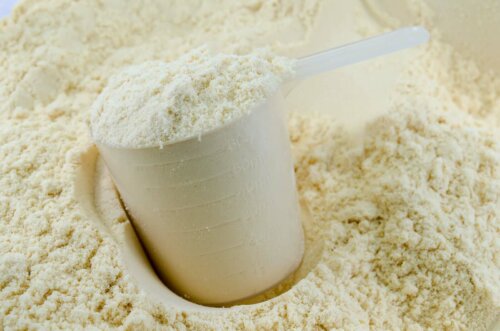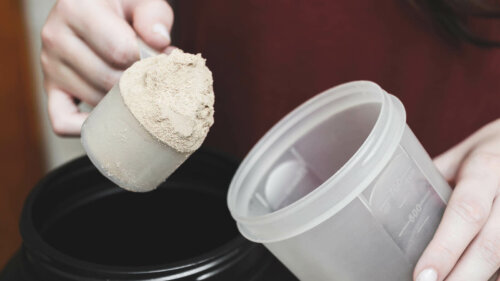Characteristics and Uses of Calcium Caseinate


Written and verified by the nutritionist Florencia Villafañe
Have you ever heard of calcium caseinate? It’s a substance derived from dairy protein. Would you like to know what it’s for? Continue reading to find out.
Calcium caseinate is a compound from casein with a high biological value. In this respect, it’s quite popular as a nutritional supplement in sports, especially in those that stimulate muscle synthesis.
What exactly is calcium caseinate?
As we started off saying above, calcium caseinate is a salt made from the extraction of milk protein.

In general, this process is carried out with the addition of specialized enzymes, or through substances such as vinegar and lemon juice. This is because these are able to reduce the acidity of dairy products and lead to the coagulation of casein.
As you can see, this kind of salt originates from the treatment of casein with calcium hydroxide.
Properties of calcium caseinate
This substance contains about 90% of its weight in protein as well as every essential amino acid. Its high biological value is due to these and they also add to its nutritional qualities.
Additionally, it contains a considerable amount of calcium and has less than 1% fat. It also contains phosphorus and sulfur in limited quantities. Not only that, but it basically contains zero lactose.
In general, caseinates are heat resistant substances, even more so than most proteins. In addition, they can easily interact with water and fats and this is why they’re powerful emulsifiers.
As you can see, these characteristics are what make these salts highly versatile as food additives in various edible products.
Check out these Delicious Recipes Rich in Protein
Uses of calcium caseinate
The best-known use of this compound is as a sports supplement. This is because casein, a protein, has an anti-catabolic effect. What this means is it prevents muscle breakdown.

The body slowly absorbs this substance after ingesting it and activates the metabolism of amino acids as it digests it — along with the synthesis of proteins. As you can see, its consumption leads to a feeling of being full.
Various studies determined that the contribution of serum proteins and caseinates is useful to achieve satiety in obese people. It’s also great for covering the protein recommendation in hospitalized patients with higher requirements for this nutrient.
Being a dietary supplement, it’s also useful for individuals who perform strength exercises, intense training, or who are looking for muscle definition. In general, its consumption is recommended before going to bed or after training.
However, it isn’t advisable to take it without consulting a qualified professional. This is because its consumption must take the current diet into consideration. Note that it won’t produce any of the mentioned effects on its own, especially if it isn’t backed by the recommended protein intake.
Uses in the food industry
Caseinates are used in food products, and in other additives and preservatives. This salt is intended to extend the shelf life of different products, provide nutritional value to them, and modify textures. In this respect, some of the products that contain them are:
- Ice cream
- Cookies
- Bread
- Instant soup
- Coffee creamers
- Breakfast cereals
- Pastries and cakes

Calcium intake
Because it’s mainly composed of calcium and has a minimal supply of lactose, this substance can supply calcium to people who are lactose intolerant. Indeed they can digest it without any problem. This is great as it prevents decalcification and contributes to the strengthening of bones and teeth.
Contraindications
Several studies suggest that casein has significant inflammatory potential, so that some individuals may be allergic to it and its derivatives.
Casein allergy
Specifically, allergic people’s bodies identify this protein as a foreign compound and release histamine in order to neutralize it. Consequently, it leads to reactions such as diarrhea, itchy throat, nasal congestion, and burning eyes, among others.
Vegans
This substance comes from cow milk, so it isn’t appropriate for those who follow vegan diets or who don’t consume dairy for any reason. This is why they must read labels and be certain that some of the products they consume such as coffee, instant soups, or cookies, don’t contain calcium caseinate.
Read about the Alternatives for Replacing Animal Protein in Your Diet
Final notes about calcium caseinate
This substance is popular as a food additive in several of the products you may consume on a daily basis. In addition, it’s also a sports supplement that you can incorporate into your diet if you’re trying to improve your muscle mass.
Keep in mind that you must consult a professional to make sure there are no contraindications before you add it to your diet.
All cited sources were thoroughly reviewed by our team to ensure their quality, reliability, currency, and validity. The bibliography of this article was considered reliable and of academic or scientific accuracy.
- Weiss-Steider, B., Córdova, Y., Aguiñiga-Sánchez, I., Ledesma-Martínez, E., Domínguez-Melendez, V., & Santiago-Osorio, E. (2019). El caseinato de sodio y la caseína α inhiben la proliferación de la línea celular mieloide de ratón 32D clone 3 (32Dcl3) mediante el TNF-α. Biomédica, 39(2), 291-299.
- Armendariz-Anguiano, A. L., Jiménez-Cruz, A., Bacardí-Gascón, M., & Pérez-Morales, M. E. (2010). Efectividad del uso de suplementos de proteína en entrenamientos de fuerza: Revisión sistemática. Archivos Latinoamericanos de Nutrición, 60(2).
- Reyna, N., Moreno-Rojas, R., Mendoza, L., Parra, K., Linares, S., Reyna, E., & Camara-Martos, F. (2016). Using whey proteins and caseins as dietetic supplements in regulation of satiating effect of overweight women. NUTRICION HOSPITALARIA, 33(1), 47-53.
- Caseinato de calcio: estructura, propiedades, obtención y usos. Disponible en: Lifeder.com
This text is provided for informational purposes only and does not replace consultation with a professional. If in doubt, consult your specialist.








